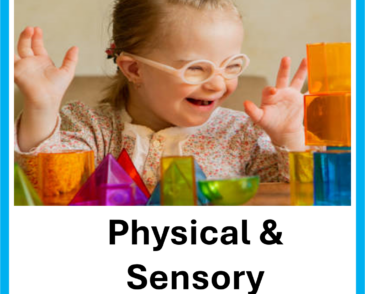

Last Updated - February 5, 2025
Each Unique Child Presents in Their Own Way – Early Years – Multi-Sensory Impairment (MSI)
- As a baby, the child will lift their head, roll over and gradually sit without support.
- The child may crawl as they gather more muscle control and co-ordination.
- The child may start standing, instead of crawling, using adults/furniture to pull themselves up and for support.
- The child will use their mouth to explore objects and pass things from one hand to the other.
- The child will gradually gain control of large movements with support e.g. walking, running, climbing, jumping.
- The child may enjoy sitting with arms or legs out wide to catch a large soft ball rolled/thrown to them.
- The child may enjoy riding on wheeled toys either push along or with guidance.
- The child may enjoy physical sensations such as swinging, rolling or sliding.
- The child may enjoy exploring with malleable materials: dough; clay; soil; finger paint.
- The child may enjoy exploring mark-making movements e.g. with a large or small brush and water or drawing materials with guiding initially to create circular, zigzag or scribbling movements.
- The child may independently pour themselves a drink by using their finger inside the cup to know when the cup is full enough.
- The child can be encouraged to feed themselves with finger foods, then using cutlery. Introducing a spoon may be easier initially.
- The child will benefit from being given choices through tactile signing or verbally or using real objects (objects of reference) which can be explored through touch.
- The child may remain mainly silent, with a limited or no use of vocalisations or babble.
- The child will respond to touch: stroking their cheek, cuddles, back rubbing.
- The child may play mainly silently.
- The child may be communicative in subtle ways which need sensitive observation to decode
- The child may use other ways of communicating other than talk to express their feelings, wants and needs with others e.g. body language, facial expression or unwanted behaviours.
- The child may indicate what they want when they need comfort: comfort object, rocking, cuddling, singing.
- The child develops a sense of self by interacting with others.
- The child is valued and supported within the group and develops a good sense of their self-worth
- The child begins to develop friendships with other children.
- The child grows confident with familiar routines and is supported with flexibility when needed by a key person and in time, other known adults.
- The child may show frequent bursts of frustration when their needs and wants are not understood.
- The child may express themselves using e.g. non-verbal actions, screams or smiles.
View and/or download the Torbay Early Years Toolkit here: Torbay Early Years Graduated Approach Toolkit – Family Hub
